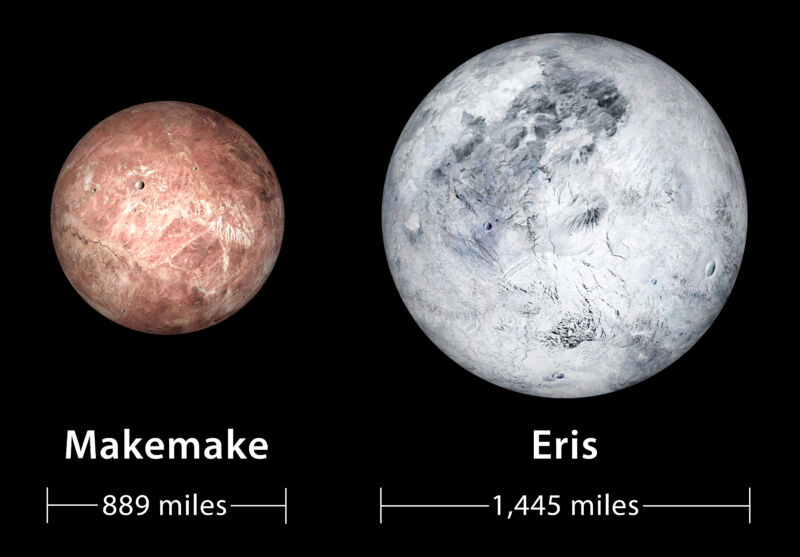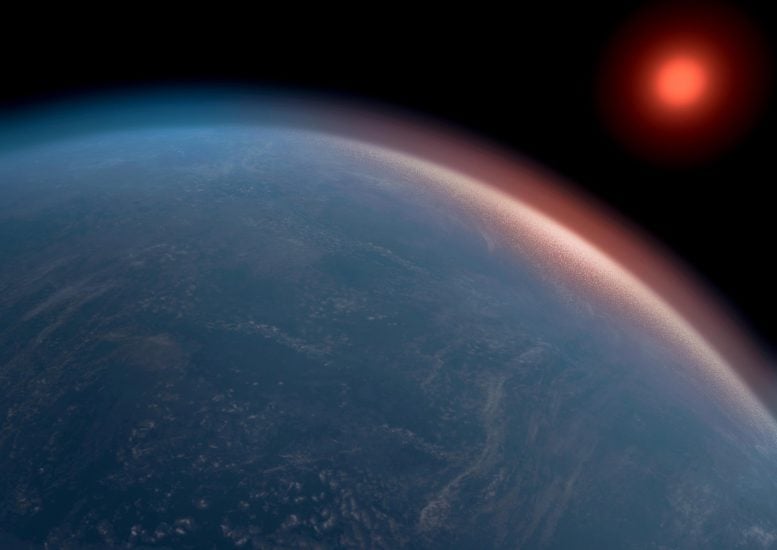
Artist's conceptions of what the surfaces of two dwarf planets might look like.
SWRI
Active geology—and the large-scale chemistry it can drive—requires significant amounts of heat. Dwarf planets near the far edges of the Solar System, like Pluto and other Kuiper Belt objects, formed from frigid, icy materials and have generally never transited close enough to the Sun to warm up considerably. Any heat left over from their formation was likely long since lost to space.
Yet Pluto turned out to be a world rich in geological features, some of which implied ongoing resurfacing of the dwarf planet's surface. Last week, researchers reported that the same might be true for other dwarf planets in the Kuiper Belt. Indications come thanks to the capabilities of the Webb telescope, which was able to resolve differences in the hydrogen isotopes found on the chemicals that populate the surface of Eris and Makemake.
Cold and distant
Kuiper Belt objects are natives of the distant Solar System, forming far enough from the warmth of the Sun that many materials that are gasses in the inner planets—things like nitrogen, methane, and carbon dioxide—are solid ices. Many of these bodies formed far enough from the gravitational influence of the eight major planets that they have never made a trip into the warmer inner Solar System. In addition, because there was much less material that far from the Sun, most of the bodies are quite small.
While they would have started off hot due to the process by which they formed, their small size means a large surface-to-volume ratio, allowing internal heat to radiate out to space relatively quickly. Since then, any heat has come from rare collision events or the decay of radioactive isotopes.
Yet New Horizons' visit to Pluto made it clear that it doesn't take much heat to drive active geology, although seasonal changes in sunlight are likely to account for some of its features. Sunlight is less likely to be an influence for worlds like Makemake, which orbits at a distance one and a half times Pluto's closest approach to the Sun. Eris, which is nearly as large as Pluto, orbits at over twice Pluto's closest approach.
Sending a mission to either of these planets would take decades, and none are in development at the moment, so we can't know what their surfaces look like. But that doesn't mean we know nothing about them. And the James Webb Space Telescope has added to what we know considerably.
The Webb was used to image sunlight reflected off these objects, obtaining its infrared spectrum—the amount of light reflected at different wavelengths. The spectrum is influenced by the chemical composition of the dwarf planets' surfaces. Certain chemicals can absorb specific wavelengths of infrared light, ensuring they don't get reflected. By noting where the spectrum dips, it's possible to figure out which chemicals are present.
Some of that work has already been done. But Webb is able to image parts of the spectrum that were inaccessible earlier, and its instruments are even able to identify different isotopes of the atoms composing each chemical. For example, some molecules of methane (CH4) will, at random, have one of their hydrogen atoms swapped out for its heavier isotope, deuterium, forming CH3D. These isotopes can potentially act as tracers, telling us things about where the chemicals originally came from.
Unexpected findings
Both Eris and Makemake have lots of methane ice on their surfaces, and there are indications of nitrogen ice on Eris, though not Makemake. Strikingly, carbon monoxide appears to be absent from most bodies, even though it's a major component of the ices found on comets, which are also thought to originate in the Kuiper Belt. That's the first hint that something odd might be going on with the surfaces of these bodies.
Also missing is any sign of the more complicated organic molecules that are typically formed when methane is exposed to radiation. These include ethane, ethylene, and acetylene. Water, carbon dioxide, and ammonia also failed to show up in the spectrum.
None of this means these chemicals aren't present on the planets. It just indicates that they're probably not major components of its surface.
The researchers also looked for the presence of methane with different isotopes of its carbon and hydrogen. These include two different versions of carbon (carbon-12 and -13), as well as hydrogen and deuterium. These measurements were converted into ratios between the two isotopes and the ratios compared to those of other bodies in the Solar System.
Bodies that far from the Sun are thought to be composed of materials that have similar isotopic ratios to the raw material that went into building the Solar System since the original isotopes have been frozen in place. Those closer to the Sun are expected to be dynamic enough to undergo chemical reactions that can alter these original ratios. So the results of the Webb imaging seemed strange, as the hydrogen-to-deuterium ratios are much lower than expected for early Solar System material, as registered in a sampling of the comet 67P/Churyumov-Gerasimenko by the Rosetta mission.
By contrast, the ratio between the two different carbon isotopes was about what you'd expect, suggesting that whatever was altering the hydrogen-to-deuterium ratio wasn't simply doing it as a function of isotope weight.
Making sense of it all
So the researchers were left with a number of mysteries. One was the unexpected hydrogen isotopes. Another was the fact that many of the expected ices seemed to be missing in the spectrum. Finally, that much methane on the surface should have reacted to produce more complex organic chemicals, as seen on other bodies of the Solar System. But those were missing as well.
The researchers noted that the hydrogen isotope ratios looked a lot like those from water found in icy bodies throughout the Solar System. So they decided to check whether some of the methane could have been formed sometime after Makemake and Eris.
The idea would involve water either reacting with a simple carbon compound, such as carbon monoxide, to produce methane or participating in the breakdown of more complex organic chemicals. Either would result in methane with a similar isotope ratio to the water that is seen elsewhere in the Solar System. But the reactions that can do so require temperatures significantly above the boiling point of water. That's a bit unexpected for icy bodies like Makemake or Eris, which don't undergo the sort of gravitational interactions that create oceans on moons like Enceladus and Mimas.
But estimates of the radioactive decay in the rocky cores of these bodies would likely create sufficiently high temperatures for a chunk of their history. This is especially true of Eris, which has a high density that suggests a relatively large rocky core. Implicit in this analysis is that the heat was probably sufficient to have created a sub-surface ocean and driven enough circulation in the ices of the crust to have brought the methane formed to the surface.
A striking possibility is that some aspects of this process might still be going on. That would explain the relative absence of complex organic chemicals on the surface of Eris and, to a lesser extent, Makemake (which has a somewhat reddish tint). This could be accounted for if some process were still bringing fresh methane to the surface. It doesn't necessarily involve a sub-surface ocean, but it will involve enough heat to cause parts of the crust to circulate between the surface and the core/crust boundary.
It's important to recognize that this work is built on a number of assumptions and approximations and can't be viewed as the last word on things. The ideas here would benefit from a better sampling of material in comets, which should share a lot of the basic chemistry with these dwarf planets but lack the potential for internal heating.
Still, given what we've learned about Pluto and other icy bodies, the ideas here don't seem as radical as they might have a few decades ago. What does seem radical is our ability to measure isotope ratios in planets that far from Earth.
Icarus, 2024. DOI: 10.1016/j.icarus.2024.115999, 10.1016/j.icarus.2023.115923 (About DOIs).




3175x175(CURRENT).thumb.jpg.b05acc060982b36f5891ba728e6d953c.jpg)
Recommended Comments
There are no comments to display.
Join the conversation
You can post now and register later. If you have an account, sign in now to post with your account.
Note: Your post will require moderator approval before it will be visible.